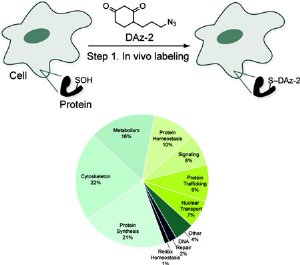Sep 2 2009
Scientists in Michigan are reporting the development of a powerful new probe for identifying proteins affected by a key chemical process important in aging and disease. The probe works like a GPS or navigation system for finding these proteins in cells. It could lead to new insights into disease processes and identify new targets for disease treatments, the researchers say. Their study is scheduled for the Sept. 18 issue of ACS Chemical Biology

Kate Carroll and colleagues note that scientists have known for years that the excess build-up of highly-reactive oxygen-containing molecules in cells can contribute to aging and possibly to disorders such as cancer and Alzheimer’s disease. Scientists believe that a diet rich in antioxidants, which are abundant in fruits and vegetables, may help deter this cell-damaging process by blocking the accumulation of these molecules, also known as reactive oxygen species (ROS). But until now, scientists have lacked the proper tools to study the effects of these molecules in detail.
The researchers developed a new molecule called DAz-2, which they say functions like a tiny GPS device for quickly finding specific proteins that are affected by ROS. The molecules do this by chemically “tagging” sulfenic acid. Formed in cells, sulfenic acid indicates that a protein has undergone a type of reaction — called oxidation — caused by ROS. In lab studies using cultured cells, the scientists identified more than 190 proteins that undergo this reaction. The study may lead to better strategies for fighting the wide range of diseases that involve these excessive oxidation reactions, the researchers say.